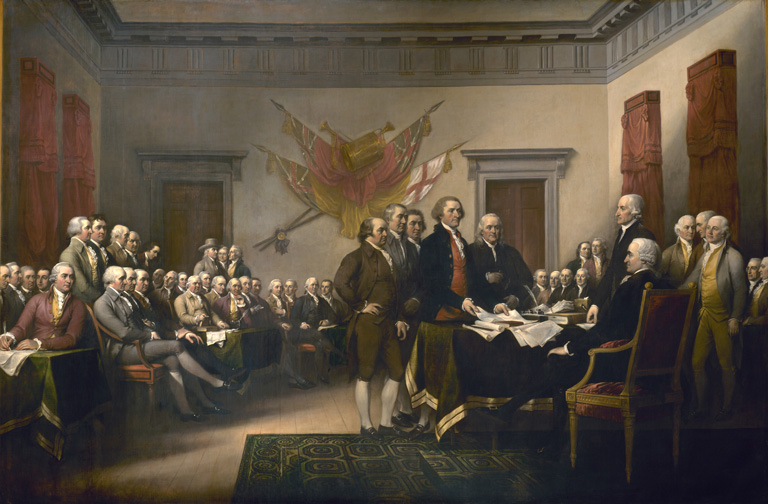–by Allie Swislocki and Joanna Hallac
The Rotunda is home to many priceless works of art, one of which is John Trumbull’s “Declaration of Independence.” It is easily one of the most recognizable works of American art, featured prominently in history books, as well as on the back of the two dollar bill. Trumbull elegantly portrays a collection of our favorite founding fathers on July 4, 1776, focusing on John Adams, Thomas Jefferson, and Benjamin Franklin presenting the just-penned Declaration of Independence to John Hancock, who is poised to put his “John Hancock” on the document. What many people do not realize, however, is that this painting is a complete inaccuracy, depicting a scene that never occurred.

The members of the Second Continental Congress voted for independence on July 2, 1776—the day John Adams believed would “be the most memorable Epocha, in the History of America…”and would “…be celebrated, by succeeding Generations, as the great anniversary Festival” (“The Book of Abigail and John: Selected Letters of the Adams Family, 1762-1784”, Harvard University Press, 1975, 142). The Declaration itself was finalized on July 4, 1776, and this is the scene Trumbull is showing us here. However, John Hancock did not sign the document until August 2, and signing would continue until January 1777 when the authenticated printed copy was first released. The final signatory’s name, Thomas McKean of Delaware, did not appear on this print, and it is possible he signed as late as 1781.
So the question remains: what would compel Trumbull to leave us with a contrived historical scene? The common belief is that it was never his intention to depict the scene as it exactly happened, but instead to preserve the document itself and its hallowed place in our nation’s history. To capture the whole essence of the Declaration of Independence, its hopes and promises for our then-fledgling nation, and the men who wrote and signed it, signaling an end to England’s colonial rule over us. It is also important to note that Trumbull did not name the painting, “Signing of the Declaration of Independence,” but instead simply “Declaration of Independence,” essentially acknowledging to all his intention to preserve the importance of the document, not the moment of the signing itself. So if you are ever on a tour of the Capitol and you hear the guide, or anyone for that matter, erroneously tell you that Trumbull’s depiction is an accurate representation of the famous scene, now you know that that is simply not the case and can kindly correct them.
While Trumbull’s intentions in painting this scene cannot be totally known to us, it seems relatively clear that he was aiming not at complete historical accuracy, but instead for preserving the American ideal as represented by the Declaration of Independence. But is that not what history often is for many? A means by which to preserve the most idealized version of ourselves within our collective memories? Perhaps, but as much as history is often subject to the interpretations of many, when those interpretations lead not to idealistic preservations of the past, as in this case with Trumbull’s painting, but rather to unrealistic perversions of it, then we are entering murky and dangerous territory. There are historical interpretations and artistic liberties, and then there are lies and half-truths; too often the differences can be so subtle that sometimes most people won’t even notice, which can carry it with it rather severe consequences. Does Trumbull’s picture fall into that latter category? We don’t think so. Has it been our interpretation of his work that has been off the mark all of these years? Yes and no, it would seem; however, we are of the belief that whether it is a historical painting or a book about a historical event or person, interpretation is inevitable, but it is always a worthwhile endeavor to keep asking questions and keep the discussion open to make sure that, over time, more and more of the “truth” will come out.
Have other questions about art and architecture in the Capitol? Feel free to ask our Capitol experts and stay tuned for more in this series of “Questions about the Capitol.”

What a well thought out and thought provoking post. I look forward to reading more to come! This blog certainly has a new viewer.
So true. Honesty and everything rengcoized.
No, anonymous 5:26/5:51 is right to ask the question. The Liberals have been very good about putting out individual policies recently but need to put them all together.
Thank you, this was a very helpful article and I hope to read more of them.
Can you please clarify something I heard from my Capitol tour guide, years ago, but now can find no backing to the story I remember being told…..
I was told John Trumbull ‘discreetly’ included himself in the rotunda paintings, until Martha Washington became aware of it, and warned him against doing so in the final painting.
But, he did so again, this time disguising himself as a woman in the final painting.
Is there any truth to this story?